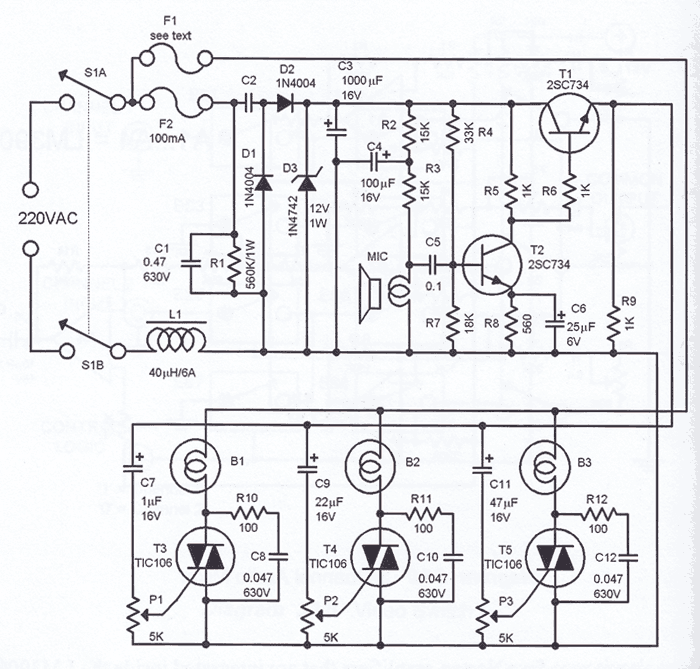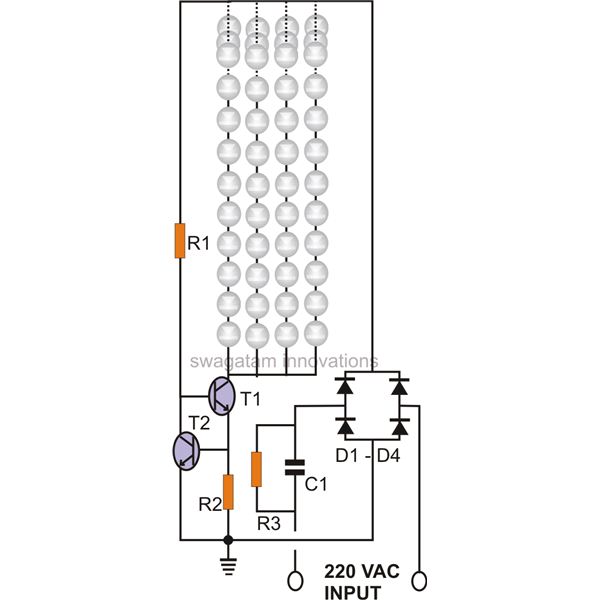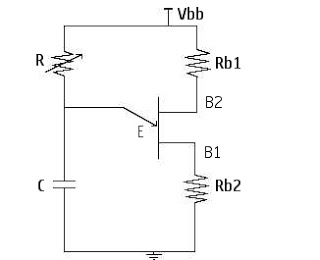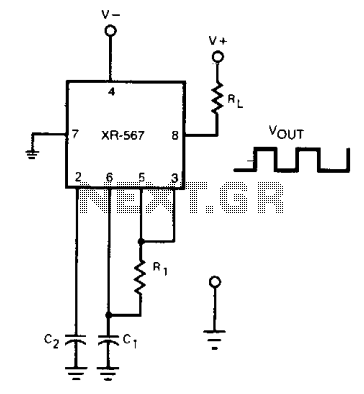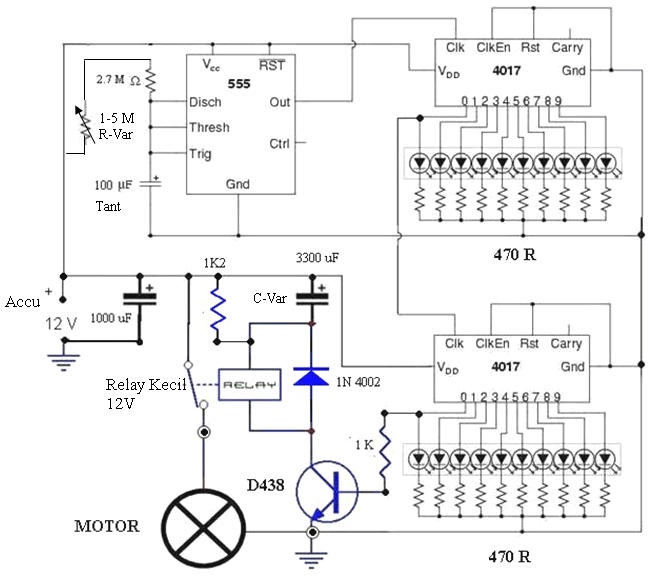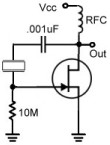
A Low-Frequency Crystal Controlled Oscillator
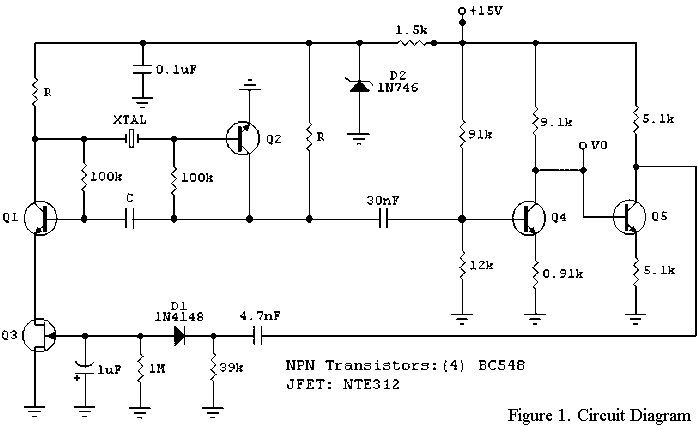
The RF engineer occasionally needs to find an instrument that can reliably and quickly test a low-frequency quartz crystal unit. This equipment is often challenging to locate, leading engineers to consult electronic circuits handbooks for schematics that can perform the required task. Unfortunately, there are not many such circuits available in the current technical literature, and those that are found do not always function as intended. A circuit that has been successfully used within the frequency range of 10 kHz to 500 kHz is illustrated in Figure 1. This schematic depicts a low-frequency sine wave oscillator characterized by low distortion, wide-band operation, and crystal control. Originally developed for laboratory applications, the circuit utilizes low-cost AF bipolar transistors for the oscillator and amplifier sections, along with a JFET for loop-gain control. The oscillator performs excellently in the 10 kHz to 500 kHz range, with measured distortion maintained below 0.1 percent. Transistors Q1, Q2, and associated circuitry create a modified astable multivibrator, with loop gain automatically adjusted to the oscillation threshold via field effect transistor Q3. Transistor Q4 amplifies the signal from the collector of Q2 and isolates the oscillator section from the output. This stage offers wide-band operation and produces a clean 2.5 Volt amplitude sine wave into a resistive load of 20k Ohms or greater. The stage including Q5 has a voltage gain of 1, designed solely to isolate the non-linear effects of rectifier D1 from the output. Additionally, Q4 amplifies minor amplitude variations in the oscillator's waveform caused by temperature changes and power supply fluctuations, feeding a magnified version of this disturbance back to rectifier D1. This feedback results in a corresponding adjustment of Q3's gate voltage, modifying the FET's drain-source resistance and thereby adjusting the loop gain slightly above unity to maintain constant output amplitude. Figure 2 provides optimal capacitor values based on the crystal's resonant frequency. Extra gain from transistors Q1 and Q2 is necessary at frequencies below 40 kHz due to the large series resistance exhibited by low-frequency crystals, as shown in Table 1, which compares typical series resistance values for low-frequency units. Consequently, resistor R is set to 10k Ohms for frequencies below 40 kHz, while a 1K Ohm resistor suffices above this frequency. The dynamic action of the JFET renders the output level nearly insensitive to power supply variations, further enhanced by a 3.3-Volt Zener diode. The accompanying photographs display a laboratory instrument based on the discussed circuit. A panel lamp illuminates when the circuit oscillates, indicating that the tested crystal is in good condition. A BNC connector is also available for waveform frequency checking. The crystal range can be selected using a three-way switch, allowing for testing at ranges of 10-40 kHz, 40-100 kHz, and 100-500 kHz. Two different sockets are provided for the crystal.
The circuit design features a low-frequency sine wave oscillator that is particularly effective for testing quartz crystals in the specified frequency range. The use of AF bipolar transistors in the oscillator and amplifier stages ensures cost-effectiveness and reliability. The modified astable multivibrator configuration, with automatic loop gain adjustment, allows for stable oscillation even in the presence of component variations and environmental factors.
The incorporation of a JFET for loop-gain control is a critical aspect of the design, as it allows for real-time adjustments to the oscillator's performance, maintaining output stability. The careful selection of components, including the Zener diode and resistors, enhances the circuit's resilience to power supply variations, which is particularly important in laboratory settings where precision is paramount.
The detailed specifications regarding the capacitor values and resistor configurations provide essential guidance for engineers seeking to optimize the circuit for specific crystal characteristics. The inclusion of a BNC connector and a three-way switch for frequency selection further enhances the versatility of the instrument, making it suitable for a wide range of testing applications.
Overall, this circuit represents a robust solution for RF engineers requiring a reliable method to test low-frequency quartz crystal units, addressing common challenges associated with existing equipment and providing a practical alternative for laboratory use.The RF engineer sometimes has to look for an instrument that will check a low frequency quartz crystal unit reliably and rapidly. This is a difficult piece of equipment to find and the engineer often has to consult an electronic circuits handbook for the schematic of a circuit that will perform the task.
Unfortunately, there aren`t many such circu its in the technical literature currently available, and when found, they don`t always work as expected. A circuit that has been found to work at full satisfaction in the frequency range from 10 kHz to 500 kHz is illustrated in Figure 1.
This is a schematic of a low frequency sine wave oscillator featuring low distortion, wide-band operation and crystal control. The circuit, originally developed for laboratory use, employs low cost AF bipolar transistors for the oscillator and amplifier sections and a JFET for loop-gain control.
Operation of the oscillator in the 10 kHz to 500 kHz frequency range has been found to be excellent, while measured distortion is kept under 0. 1 percent Q1, Q2 and associated circuitry form a modified astable multivibrator in which the loop gain is automatically adjusted to the threshold of oscillation by means of field effect transistor Q3.
Q4 linearly amplifies the signal present at the collector of Q2 and isolates the oscillator section of the circuit from the output. This stage features wide-band operation and delivers a clean 2. 5 Volt amplitude sine wave into a resistive load greater than or equal to 20k Ohms. The stage comprising Q5 has a voltage gain of 1 and its sole purpose is to isolate the non-linear effects of rectifier D1 from the output.
Transistor Q4 also amplifies the minor changes in amplitude of the oscillator`s waveform due to temperature effects and/or power supply variations, so a magnified version of the perturbance is fed back to rectifier D1 producing a corresponding change in Q3`s gate voltage. This action modifies the FET`s drain-source resistance and hence adjusts the loop gain to a new value slightly above unity, just enough to maintain a constant amplitude in the output.
Figure 2 shows optimum values for capacitor C according to the crystal`s resonant frequency. Extra gain is needed from transistors Q1 and Q2 at frequencies below 40 kHz. This is due to the fact that low frequency crystals exhibit large values of series resistance, affecting loop gain (Table 1 compares typical values of series resistance for low frequency units). According to what has been stated, resistor R is made 10k Ohms for frequencies under 40 kHz. Above this value, 1K Ohm will do. Due to the dynamic action of the JFET the output level is almost insensitive to power supply variations.
The 3. 3-Volt Zener diode further enhances this result. NOTE: The photographs show a lab instrument based on the circuit discussed. A panel lamp glows when the circuit is oscillating, indicating that the crystal being tested is in a good condition. Furthermore, a BNC connector permits checking of the waveform`s frequency. Crystal range can be selected by means of a three-way switch, i. e. , 10 ~ 40 kHz, 40 ~ 100 kHz and 100 ~ 500 kHz. Two different sockets are available for the crystal. 🔗 External reference
The circuit design features a low-frequency sine wave oscillator that is particularly effective for testing quartz crystals in the specified frequency range. The use of AF bipolar transistors in the oscillator and amplifier stages ensures cost-effectiveness and reliability. The modified astable multivibrator configuration, with automatic loop gain adjustment, allows for stable oscillation even in the presence of component variations and environmental factors.
The incorporation of a JFET for loop-gain control is a critical aspect of the design, as it allows for real-time adjustments to the oscillator's performance, maintaining output stability. The careful selection of components, including the Zener diode and resistors, enhances the circuit's resilience to power supply variations, which is particularly important in laboratory settings where precision is paramount.
The detailed specifications regarding the capacitor values and resistor configurations provide essential guidance for engineers seeking to optimize the circuit for specific crystal characteristics. The inclusion of a BNC connector and a three-way switch for frequency selection further enhances the versatility of the instrument, making it suitable for a wide range of testing applications.
Overall, this circuit represents a robust solution for RF engineers requiring a reliable method to test low-frequency quartz crystal units, addressing common challenges associated with existing equipment and providing a practical alternative for laboratory use.The RF engineer sometimes has to look for an instrument that will check a low frequency quartz crystal unit reliably and rapidly. This is a difficult piece of equipment to find and the engineer often has to consult an electronic circuits handbook for the schematic of a circuit that will perform the task.
Unfortunately, there aren`t many such circu its in the technical literature currently available, and when found, they don`t always work as expected. A circuit that has been found to work at full satisfaction in the frequency range from 10 kHz to 500 kHz is illustrated in Figure 1.
This is a schematic of a low frequency sine wave oscillator featuring low distortion, wide-band operation and crystal control. The circuit, originally developed for laboratory use, employs low cost AF bipolar transistors for the oscillator and amplifier sections and a JFET for loop-gain control.
Operation of the oscillator in the 10 kHz to 500 kHz frequency range has been found to be excellent, while measured distortion is kept under 0. 1 percent Q1, Q2 and associated circuitry form a modified astable multivibrator in which the loop gain is automatically adjusted to the threshold of oscillation by means of field effect transistor Q3.
Q4 linearly amplifies the signal present at the collector of Q2 and isolates the oscillator section of the circuit from the output. This stage features wide-band operation and delivers a clean 2. 5 Volt amplitude sine wave into a resistive load greater than or equal to 20k Ohms. The stage comprising Q5 has a voltage gain of 1 and its sole purpose is to isolate the non-linear effects of rectifier D1 from the output.
Transistor Q4 also amplifies the minor changes in amplitude of the oscillator`s waveform due to temperature effects and/or power supply variations, so a magnified version of the perturbance is fed back to rectifier D1 producing a corresponding change in Q3`s gate voltage. This action modifies the FET`s drain-source resistance and hence adjusts the loop gain to a new value slightly above unity, just enough to maintain a constant amplitude in the output.
Figure 2 shows optimum values for capacitor C according to the crystal`s resonant frequency. Extra gain is needed from transistors Q1 and Q2 at frequencies below 40 kHz. This is due to the fact that low frequency crystals exhibit large values of series resistance, affecting loop gain (Table 1 compares typical values of series resistance for low frequency units). According to what has been stated, resistor R is made 10k Ohms for frequencies under 40 kHz. Above this value, 1K Ohm will do. Due to the dynamic action of the JFET the output level is almost insensitive to power supply variations.
The 3. 3-Volt Zener diode further enhances this result. NOTE: The photographs show a lab instrument based on the circuit discussed. A panel lamp glows when the circuit is oscillating, indicating that the crystal being tested is in a good condition. Furthermore, a BNC connector permits checking of the waveform`s frequency. Crystal range can be selected by means of a three-way switch, i. e. , 10 ~ 40 kHz, 40 ~ 100 kHz and 100 ~ 500 kHz. Two different sockets are available for the crystal. 🔗 External reference
